高级中学高中英语必修一(人教版)Unit2语法教学设计-
(完整word版)人教版英语必修一第二单元-unit2教学设计
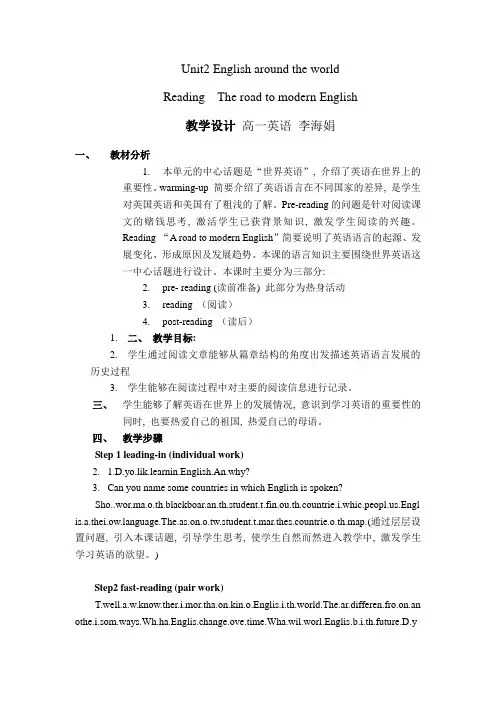
Unit2 English around the worldReading The road to modern English教学设计高一英语李海娟一、教材分析1.本单元的中心话题是“世界英语”, 介绍了英语在世界上的重要性。
warming-up 简要介绍了英语语言在不同国家的差异, 是学生对英国英语和美国有了粗浅的了解。
Pre-reading的问题是针对阅读课文的赌钱思考, 激活学生已获背景知识, 激发学生阅读的兴趣。
Reading “A road to modern English”简要说明了英语语言的起源、发展变化、形成原因及发展趋势。
本课的语言知识主要围绕世界英语这一中心话题进行设计。
本课时主要分为三部分:2.pre- reading (读前准备) 此部分为热身活动3.reading (阅读)4.post-reading (读后)1.二、教学目标:2.学生通过阅读文章能够从篇章结构的角度出发描述英语语言发展的历史过程3.学生能够在阅读过程中对主要的阅读信息进行记录。
三、学生能够了解英语在世界上的发展情况, 意识到学习英语的重要性的同时, 也要热爱自己的祖国, 热爱自己的母语。
四、教学步骤Step 1 leading-in (individual work)2. 1.D.yo.lik.learnin.English.An.why?3.Can you name some countries in which English is spoken?.Engl nguage.The.as.on.o.tw.student.t.mar.thes.countrie.o.th.map.(通过层层设置问题, 引入本课话题, 引导学生思考, 使学生自然而然进入教学中, 激发学生学习英语的欲望。
)Step2 fast-reading (pair work)T.well.a.w.know.ther.i.mor.tha.on.kin.o.Englis.i.th.world.The.ar.differen.fro.on.an othe.i.som.ways.Wh.ha.Englis.change.ove.time.Wha.wil.worl.Englis.b.i.th.future.D.yChec.th.answers.As.som.student.t.tel.thei.answers.afte.givin.th.answers.the.shoul .als.tel.ho.the.fin.th.answers.(快速阅读后要求学生了解文章大意, 并能对全文的结构有一个认识。
人教版英语必修一Unit 2(The Road to Modern English)教学设计
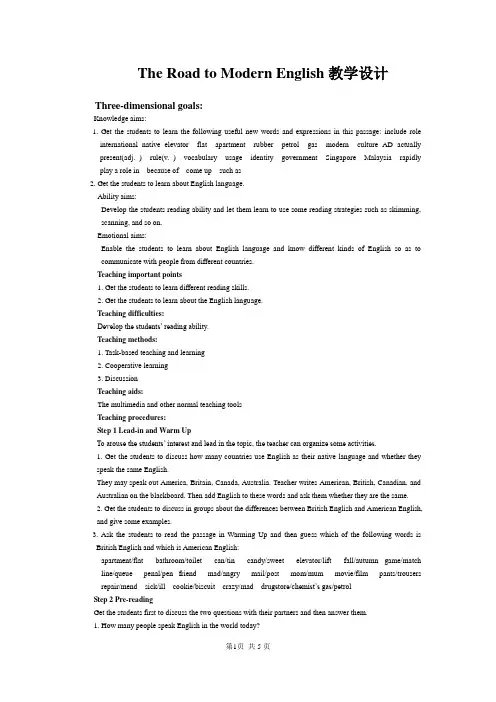
The Road to Modern English教学设计Three-dimensional goals:Knowledge aims:1. Get the students to learn the following useful new words and expressions in this passage: include roleinternational native elevator flat apartment rubber petrol gas modern culture AD actually present(adj. )rule(v. )vocabulary usage identity government Singapore Malaysia rapidly play a role in because of come up such as2. Get the students to learn about English language.Ability aims:Develop the students reading ability and let them learn to use some reading strategies such as skimming, scanning, and so on.Emotional aims:Enable the students to learn about English language and know different kinds of English so as to communicate with people from different countries.Teaching important points1. Get the students to learn different reading skills.2. Get the students to learn about the English language.Teaching difficulties:Develop the students’ reading ability.Teaching methods:1. Task-based teaching and learning2. Cooperative learning3. DiscussionTeaching aids:The multimedia and other normal teaching toolsTeaching procedures:Step 1 Lead-in and Warm UpTo arouse the students’ interest and lead in the topic, the teacher can organize some activities.1. Get the students to discuss how many countries use English as their native language and whether they speak the same English.They may speak out America, Britain, Canada, Australia. Teacher writes American, British, Canadian, and Australian on the blackboard. Then add English to these words and ask them whether they are the same. 2. Get the students to discuss in groups about the differences between British English and American English, and give some examples.3. Ask the students to read the passage in Warming Up and then guess which of the following words is British English and which is American English:apartment/flat bathroom/toilet can/tin candy/sweet elevator/lift fall/autumn game/match line/queue penal/pen friend mad/angry mail/post mom/mum movie/film pants/trousers repair/mend sick/ill cookie/biscuit crazy/mad drugstore/chemist’s gas/petrolStep 2 Pre-readingGet the students first to discuss the two questions with their partners and then answer them.1. How many people speak English in the world today?2. Why do so many people speak English?Suggested answers:1. About 1500 million people speak English as their first, second or foreign language.2. The reasons why so many people speak English:1)English is one of the official languages of the Olympic Games and the United Nations.2)English dominates international websites and provides nearly all of the new computer terminology.3)Tourism and trade from Western Europe and North America has contributed to the spread of English.4)Satellite TV, radio programs and, of course, Hollywood films all broadcast English into China. Also, anumber of Chinese films include English subtitles.Step 3 Reading1. Listening & SkimmingAsk the students to listen to the tape and read the reading passage to get the main idea of the text. (Let them find out key sentence of each paragraph or ask them to summarize the main point for each paragraph in their own words. )Paragraphs Main ideasParagraph 1Paragraph 2Paragraph 3Paragraph 4Paragraphs Main ideasParagraph 1 The spread of the English language in the worldParagraph 2 Native speaker can understand each other but they may not be able to understand everything.Paragraph 3 All languages change when cultures communicate with one another.Paragraph 4 English is spoken as a foreign language or second language in Africa and Asia.2. Scanning1)Go through Comprehending Exercise 1 and make sure the students know what to do. Let them read thewhole passage carefully to locate particular information decide whether the statements are true or false and give the reasons.2)Choose the best answer and see whether you’ve really understood the text.(1)The passage mainly tells us______________.A. why English is more and more widely used in the world todayB. a very brief history of the English languageC. the difference between British English and American EnglishD. the different kinds of the English language in the world(2)“English became closer to the language you are learning now. ” Here the word “close”means______________.A. very alikeB. shortC. nearD. careful(3)From this passage we can infer that the English language was once influenced by____________.A. the Chinese languageB. South AfricaC. South AsiaD. both German and French(4)From this passage we can see that______________.A. the author is quite sure that Chinese English will become one of the world EnglishB. the author has no idea whether or not Chinese English will become one of the world EnglishC. the author thinks that government and education play an important role in English learningD. the author feels every satisfied to see more and more Chinese people are learning English Suggested answers:(1)B(2)A(3)D(4)B3. Intensive readingAsk the Ss to read the passage carefully paragraph by paragraph to get some detail information.How many people spoke English at the end of the 16th century?Where did they live?Why was English spoken in many other countries in the 17th century?Do native English speakers have difficulty in understanding each other?Does their English have differences? If so, can you show examples?Why has English changed over time?Why was Shakespeare able to ma ke use of a wider vocabulary by the 1600’s?What happened to American English in the 19th century?Who gave American English its own identity?Why did India take English as second language?.Do you know any other kinds of English formed for this reason?After the Ss’ reading, do the time line to master how English changed over time.4. Language problemsWhile checking the answers with the whole class, deal with any language problems to see whether the students can guess the meanings of new vocabulary such as voyage, base, make use of, a number of, etc.5. summaryPlay the tape of the passage for the students to listen to and follow. Play the tape of part of the passage once more; this time the students listen and repeat.English is a language spoken all over the world. But at first the English spoken in England between about AD450 and 1150 was very different from the English spoken today. It was more based on German than the English we speak now, later English became less like German because new settlers enriched the English language and Its vocabulary. So by the 1600s Shakespeare was able to make use of a wider vocabulary than ever before. Finally by the 19th century the language was settled because dictionaries were written. Now, English is also spoken as a foreign or second language in South Asia.6. Further thinking:Work in groups. Discuss the following two question and then ask two groups to report their answers to the class.According to the passage, languages change when cultures communicate with one another. So the writer intended to predict a possible road to modern English, that is, when Chinese culture communicates with English culture, English may change, too. So as time goes by, Chinese English may become one of the world English. That is what the writer intended to tell us about this passage. So the writer gave it the title-The Road to Modern English.(All persuasive reasons can be accepted. )7.DiscussionSome people say that Chinese is a much more elegant language, so it is more important for us to master it and it is not so necessary to master foreign language. Do you agree with this opinion and why?Step 4 WorkbookDo Exercises 1 and 2 in Using words and expressions on Page 49.Step 5 Homework1. Learn the new words and expressions in this part by heart.2. Read the text again and again. Try to retell it.教学反思:这节课是阅读课,主要训练学生的阅读能力,兼顾学生的听、说、读、写的能力。
高中英语必修一人教版:Unit+2+语法+教学设计-.doc
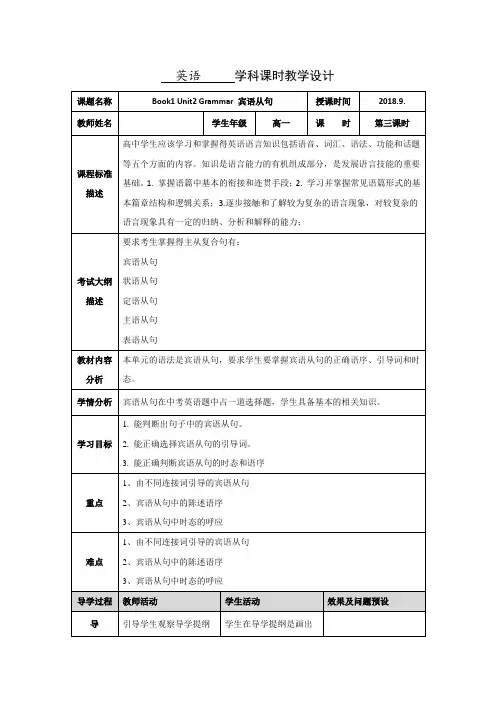
英语学科课时教学设计检查结果及修改意见:合格[ ] 不合格[ ]组长(签字):检查日期:年月日精美句子1、善思则能“从无字句处读书”。
读沙漠,读出了它坦荡豪放的胸怀;读太阳,读出了它普照万物的无私;读春雨,读出了它润物无声的柔情。
读大海,读出了它气势磅礴的豪情。
读石灰,读出了它粉身碎骨不变色的清白。
2、幸福幸福是“临行密密缝,意恐迟迟归”的牵挂;幸福是“春种一粒粟,秋收千颗子”的收获. 幸福是“采菊东篱下,悠然见南山”的闲适;幸福是“奇闻共欣赏,疑义相与析”的愉悦。
幸福是“随风潜入夜,润物细无声”的奉献;幸福是“夜来风雨声,花落知多少”的恬淡。
幸福是“零落成泥碾作尘,只有香如故”的圣洁。
幸福是“壮志饥餐胡虏肉,笑谈渴饮匈奴血”的豪壮。
幸福是“先天下之忧而忧,后天下之乐而乐”的胸怀。
幸福是“人生自古谁无死,留取丹心照汗青”的气节。
3、大自然的语言丰富多彩:从秋叶的飘零中,我们读出了季节的变换;从归雁的行列中,我读出了集体的力量;从冰雪的消融中,我们读出了春天的脚步;从穿石的滴水中,我们读出了坚持的可贵;从蜂蜜的浓香中,我们读出了勤劳的甜美。
4、成功与失败种子,如果害怕埋没,那它永远不能发芽。
鲜花,如果害怕凋谢,那它永远不能开放。
矿石,如果害怕焚烧(熔炉),那它永远不能成钢(炼成金子)。
蜡烛,如果害怕熄灭(燃烧),那它永远不能发光。
航船,如果害怕风浪,那它永远不能到达彼岸。
5、墙角的花,当你孤芳自赏时,天地便小了。
井底的蛙,当你自我欢唱时,视野便窄了。
笼中的鸟,当你安于供养时,自由便没了。
山中的石!当你背靠群峰时,意志就坚了。
水中的萍!当你随波逐流后,根基就没了。
空中的鸟!当你展翅蓝天中,宇宙就大了。
空中的雁!当你离开队伍时,危险就大了。
地下的煤!你燃烧自己后,贡献就大了6、朋友是什么?朋友是快乐日子里的一把吉它,尽情地为你弹奏生活的愉悦;朋友是忧伤日子里的一股春风,轻轻地为你拂去心中的愁云。
朋友是成功道路上的一位良师,热情的将你引向阳光的地带;朋友是失败苦闷中的一盏明灯,默默地为你驱赶心灵的阴霾。
2019人教版高中英语必修一Unit 2 语法课-活动观设计
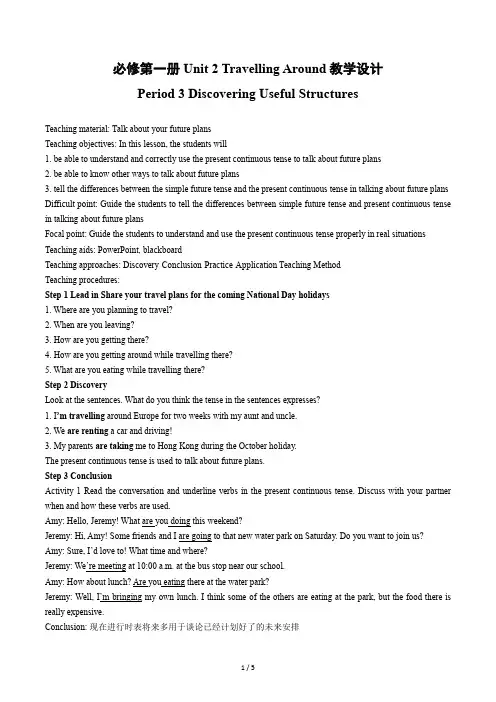
必修第一册 Unit 2 Travelling Around教学设计Period 3 Discovering Useful StructuresTeaching material: Talk about your future plansTeaching objectives: In this lesson, the students will1. be able to understand and correctly use the present continuous tense to talk about future plans2. be able to know other ways to talk about future plans3. tell the differences between the simple future tense and the present continuous tense in talking about future plans Difficult point: Guide the students to tell the differences between simple future tense and present continuous tense in talking about future plansFocal point: Guide the students to understand and use the present continuous tense properly in real situations Teaching aids: PowerPoint, blackboardTeaching approaches: Discovery-Conclusion-Practice-Application Teaching MethodTeaching procedures:Step 1 Lead in Share your travel plans for the coming National Day holidays1. Where are you planning to travel?2. When are you leaving?3. How are you getting there?4. How are you getting around while travelling there?5. What are you eating while travelling there?Step 2 DiscoveryLook at the sentences. What do you think the tense in the sentences expresses?1. I’m travelling around Europe for two weeks with my aunt and uncle.2. We are renting a car and driving!3. My parents are taking me to Hong Kong during the October holiday.The present continuous tense is used to talk about future plans.Step 3 ConclusionActivity 1 Read the conversation and underline verbs in the present continuous tense. Discuss with your partner when and how these verbs are used.Amy: Hello, Jeremy! What are you doing this weekend?Jeremy: Hi, Amy! Some friends and I are going to that new water park on Saturday. Do you want to join us? Amy: Sure, I’d love to! What time and where?Jeremy: We’re meeting at 10:00 a.m. at the bus stop near our school.Amy: How about lunch? Are you eating there at the water park?Jeremy: Well, I’m bringing my own lunch. I think some of the others are eating at the park, but the food there is really expensive.Conclusion: 现在进行时表将来多用于谈论已经计划好了的未来安排1. 用于大多数表示位置移动的动词(位移动词)(短语):go, come, travel, leave, bring, take, arrive, return, start, fly, visit, take off, land, see off, set off等2. 也可用于非位移动词(短语):eat, do, meet, plan, buy, have, spend, play, finish, stay, rent, book, attend, pack, contact, apply for, pick up, check out等,此时常常与表示将来的时间状语连用。
人教版高中英语必修一 第二单元 教学设计
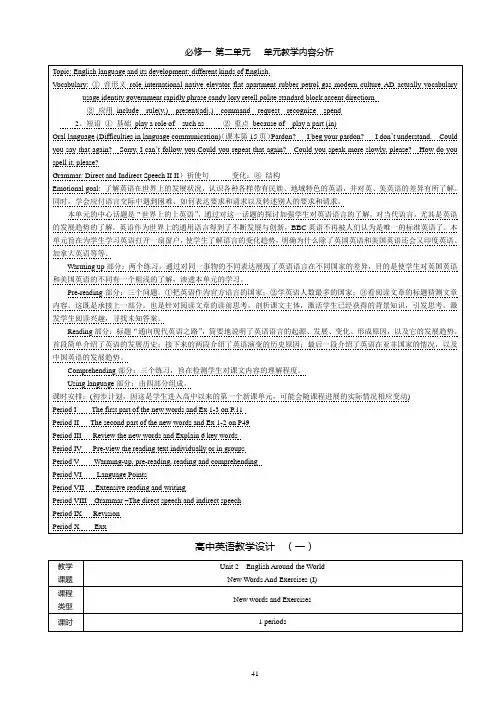
课时安排:(初步计划,因这是学生进入高中以来的第一个新课单元,可能会随课程进展的实际情况相应变动)
Period IThe first part of the new words and Ex 1-3 on P.11
Period IIThe second part of the new words and Ex 1-2 on P49
Finish the Exx individually or in groups
本节课中的重点与中心环节,希望通过本节的设置,能让学生在实际运用中较为有效的识记单词,体会语用的功效。
min
Step 6
Checking
If time permits,Check the answers
Check the answers and correct their own.Try to be clear why they are right or wrong.
教学
重点
1 Pronounce the new words and expressions correctly. 2 Grasp the use of some key words.
3 Learn at least one way to memorize new words and expressions
学情
分析
Ss have poor vocabulary, and the worse is that they still don’t have an essential way to enrich their vocabulary.So, this period will help them to realize how to memorize words in practical using.
高中英语 新人教版必修一 welcome unit 教案2(语法和写作)
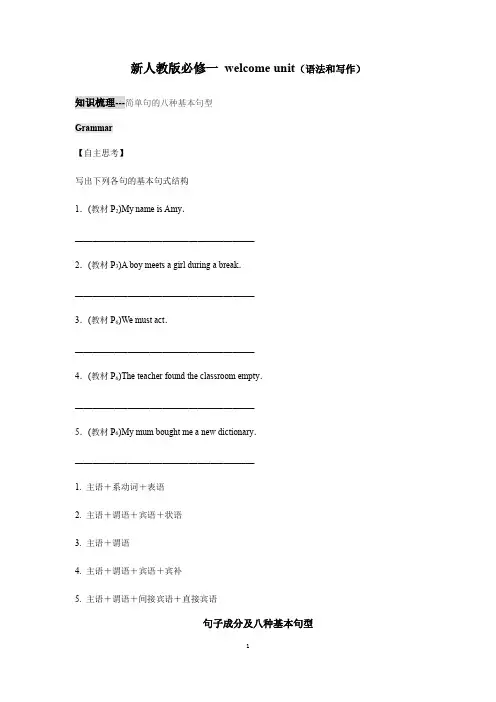
新人教版必修一welcome unit(语法和写作)知识梳理---简单句的八种基本句型Grammar【自主思考】写出下列各句的基本句式结构1.(教材P2)My name is Amy._________________________________________2.(教材P3)A boy meets a girl during a break._________________________________________3.(教材P6)We must act._________________________________________4.(教材P6)The teacher found the classroom empty._________________________________________5.(教材P6)My mum bought me a new dictionary._________________________________________1. 主语+系动词+表语2. 主语+谓语+宾语+状语3. 主语+谓语4. 主语+谓语+宾语+宾补5. 主语+谓语+间接宾语+直接宾语句子成分及八种基本句型考点一:句子成分句子表达一个完整的意思,是由单词按一定的语法规则组合而成的。
句子一般可以分成几个部分,每个部分在句中具有一定的功能,称为句子成分。
不同的句子成分由一定的词类或词组充当。
1.主语(subject)主语是一句话的主体,表明句子说的是谁或是什么。
它一般放在谓语之前,通常由名词(名词短语)、代词、数词、动词不定式、动名词以及名词性从句等担任。
◆TV news often gives us lots of information.电视新闻常常给我们许多信息。
(名词)◆Something is wrong with my computer.我的电脑坏了。
(代词)◆Seventenths of the earth surface is covered with water.十分之七的地球表面被水覆盖。
人教版高中英语必修一Unit2 Grammar 教学设计
Unit2 Grammar 教学设计Direct Speech and Indirect Speech (Ⅱ): requests and commands教学设计设计意图This is the last teaching period of this unit, aiming to help students get a basic knowledge of the grammar in this unit. The emphasis of this period is mainly placed on understanding and using the grammar. Therefore, teachers should create a relatively real context to present enough sentences for students to draw a conclusion about the rules of how to change direct speech into indirect speech when one gives a command or a request. In the meantime, teachers should offer more opportunities for students to practice. Exercises designed ought to be simple and easy to operate, which is of great help to students’ understanding, to somewhat difficult questions to enhance stude nts’ ability.教学重点Enable students to get familiar with how to change direct speech into indirect speech when they use the sentences to give a command or a request.教学难点Get students to master the rules and enable them to use these rules.知识目标Help students to know the rules of this grammar point: tell/order/command/ ask/advise somebody to do something or suggest doing something.Enable students to use the rules to make new sentences.教学过程Task 1 复习Lead-inHello, everybody!Today we are going to learn something new about Direct Speech and Indirect Speech. Since you have learned something about it in Unit 1, let’s have a revision. The situation is:Mary wanted to go swimming. On her arrival, she found John was already there.Look at the screen about four sentences that Mary said and change them into indirect speech. When you do the exercises, pay special attention to the rules.I. Change the sentences from direct speech into indirect speech.1. She said, “I want to go swimming now.”2. She said, “John, when did you set off for the swimming pool?”3. She said to John, “Do you come here by bike or by bus?”4. She said, “Practice makes perfect.”The teacher gives students several minutes to finish the exercises. Students give the answers and they also need to point out the rules. The teacher writes down the key words of the rules on the blackboard.When students give their answers, make sure that they:①have a good command of the rules about the change of persons, tenses, pronouns and adverbials.②know the differences about the transformation between declarative sentences and interrogative sentences.Ⅱ. Fill in the blanks.1. A. She said, “My brother left home three years ago.”B. She said brother home three years .2. A: He asked me, “Will you go to the park this evening?”B: He asked me I to the park evening.3. A: She said, “What are you doing?”B: She asked me doing.Ⅲ. Multiple choices.1. I asked them they got married.A. whoB. thatC. whichD. when2. ——What did she think of the film?。
人教版高一英语必修一unit2教案
人教版高一英语必修一Unit 2教案教学目标:1. 知识目标:学习并运用情态动词的被动语态的基本用法及一些固定句型。
2. 能力目标:提高运用知识的能力。
3. 德育目标:了解一些关于环境保护的常识,树立学生的环保意识。
教学内容和过程:一、Warming-up (热身)1. 教师放录音,学生回答书本上的问题。
[设计意图]:通过听力训练,一方面提高学生的听力,另一方面为对话的学习做好铺垫。
2. 学生展示自己制作的图片,用英语介绍自己的作品。
[设计意图]:展示自己的作品,一方面可以提高学生的兴趣,另一方面为下一步的对话学习作准备。
二、Presentation (呈现)1. 教师出示图片,介绍一家手工艺品店。
引出新词:craftsmen, artisan, introduce, showcase 等。
[设计意图]:出示图片,介绍商店及新词汇,为下一步的学习扫清语言障碍。
2. 教师介绍新词汇:have got to, be in the habit of等。
并领读。
[设计意图]:使这些重要的情态动词呈现出来,并教读。
3. 呈现并学习新的句型结构:The craftsmen have to work hard to improve their skills. We must protect our environment. The sculpture is made of recycled materials. The artisan has to follow certain rules and regulations. We should not damage the showcase. 等。
并领读。
[设计意图]:呈现新的句型,为下一步的学习扫清语言障碍。
4. 教师介绍本单元的主题——环境保护和生态平衡。
通过讨论和观看一段录象帮助学生熟悉这些句型。
然后让学生试着使用这些句型进行口头表达。
教师进行点评。
[设计意图]:这一环节通过引导学生对环境保护这一话题进行讨论,使他们形成对环保问题的正确认识,增强他们的环保意识,同时熟悉并运用新句型。
人教版高中英语必修一 Unit 2 English around the world全单元教案(精品)
Unit 2 English around the worldThe First Period●三维目标1.Knowledge:Master the words and phrases and get a view of the road to modern English.2.Ability:Train students’ reading skill.3.Emotion:Let students know more about English and inspire students to study English hard.●教学重点The understanding and comprehension of the passage.●教学难点(1)How to get to master the useful words and expressions.(2)How to improve students’ ability to read an article.Step 1 GreetingsT:Good morning,boys and girls!S:Good morning,teacher!Step 2 Warming upT:English is a widely used language.Do you know in which countries English is spoken as their native language?S a:The US,the UK,Australia,Canada...T:(a slide:Nancy:Oh,there you are.Now then,did you have a good flight?Joe:Sure,we flew all the way direct from Seattle to London.Nancy:You must be very tired.Did you sleep at all on the plane?Joe:No,not really.I’m very tired.Could I use your bathroom?Nancy:Why,of course.You don’t need to ask,just make yourself at home.Let me give you a clean towel.Joe:A towel?Nancy:Yes.Here you are.The bathroom is upstairs.It’s the second door on the left.(After a while)Nancy:Have you found it?Joe:Well,eh,yes,I mean no. I mean,I found the bathroom,but I didn’t find what I was looking for!)Here is a short dialogue.Read it and discuss with your partner:What is it that Joe can’t find in the bathroom?Why can’t he find it?S b:It is the toilet.T:And why?S c:Perhaps when Joe says “bathroom”,he means a place,where there is a toilet.But in Nancy’s eyes,it is a place where people can only have a bath.T:You are right.Do you know why there’s a misunderstanding between them?S d:Because they speak different kinds of English.T:Great.There’s more than one kind of English in the world.In some important ways they’redifferent.They’re called world English.Can you guess what they include?S e:Canadian,British,American,Australian and Indian English.T:Right.So you know even two native speakers of English may still not speak the same kind of English.Look at the examples on P9.Now try to guess which of the following words are British English and which are American English.Suggested answers:Am.English:mom;on a team;rubber;gasBr.English:mum;in a team;eraser;petrolStep 3 New WordsT:From today on,we’ll learn something about English around the world.First of all,let’s get familiar with the new words.Yesterday I asked you to read the new words and look up the meaning of them.Now let’s have a game in which one of you tells us the meaning or the explanation of the words and the others guess which word it is.Let’s go!Suggested explanation:1.include:have something or somebody as one of a group.e.g.:The tour included a visit to the Science Museum.2.play a role in:have a part in3.international:connected with two or more countries4.native:(1)connected with the place where you have always lived or have lived for a long time(2)a person who lives in a particular place,especially sb. who has lived there a long time5.elevator:lift6.flat:(1)having a smooth surface (2)(Br. E)a set of rooms for living in7.apartment:(Am. E)a set of rooms for living in8.modern:of the present time or recent timee up:to move toward10.culture:the customs and beliefs,art,way of life and social organization of a particular country or group11.actually:really;in fact12.present:(1)existing or happening now (2)being in a particular place13.rule:control14.vocabulary:all the phrases and phrases you learnage:the way in which words are used in a language16.identity:who or what sb./sth. isernment:the group of people who are responsible for controlling a country or a state18.rapidly:fastT:That’s great!You’ve made a good preparation.Now please read the words together.(show words and explanations on the slide)Step 4 Pre-readingT:Just now,we’ve known that there’re many kinds of English in the world.Then why are there so many kinds?Ss:We don’t know.T:Anyway,we’ll find out the cause today.Now read the title of the passage “the road to modern English”.What do you think it will tell us?S f:I guess it will tell us the development of English.Step 5 SkimmingT:Now let’s find out whether your answer is right.So please read the passage fast in silence and find out the main idea of each paragraph.Suggested answer:Para.1:Brief introduction of the change in English.Para.2:An example of different kinds of English.Para.3:The development of English.Para.4:English spoken in some other countries.Step 6 ScanningT:You’ve mastered the structure of the passage.Now please read para.1 and 2 loud in detail.T:(several minutes later)Have you finished?Here’re some statements of which some are right while some not.Read them and then tell whether they are true or false.If false,please find out the mistake and correct it.(slides:1.Most of the English speakers in the 16th century lived in England.2.More and more people use English as their first or 2nd language.3.The US has the largest number of English speakers.4.Native English speakers can understand everything because they speak the same kind of English.)S g:The first one is true.S h:The second one is true.S i:The third one is false.China has the largest number of English speakers.S j:The fourth one is false.Native English speakers may not be able to understand everything because they do not speak the same kind of English.T:You did a very good job.Now please read para.3 after the tape.And then fill in the form oneffect that Chinese has on English?S k:In English there are some Chinese words such as gongfu,long time no see,...T:Great!With more closely communication of culture,English is changing more frequently.T:As we all know,English is spoken as the native language mostly in western countries.Then what about English in some other parts of the world?After reading the last paragraph,would you please say something about the present situation of English in your own words?S l:It is also spoken as a foreign or 2nd language in many other countries.For example,inIndia,it is used for government and education.In some African and Asian countries,it is also spoken,such as in South Africa,Singapore and Malaysia.While in China,the number of English speakers is increasing fast.T:Quite good.Step 7 DiscussionT:So far,we’ve known that English is becoming more and more important in China.It has been an important subject for Chinese students.But someone say that Chinese is a much more elegant language.So it is more important for us to master it and it is not so necessary for us to master a foreign language.Do you agree with this opinion and why?Suggested answer:I don’t agree with it.With the cultural communication becoming more and more frequent,the chance to contact foreigners,exported goods,international conferences,and so on,is more and more.As the most widely used language,English is regarded as the language used in most international situations.Thus,if we want to keep up with the times,we’d better master English and use it as a tool.Step 8 Summary and homeworkT:Today we’ve learned an article on “the road to modern English”.After class,you should read it again and again to get the idea of the text further.Do the exercises of comprehending and try to tell your partner something about English in our own words.That’s all for today.Class is over.The Second Period●三维目标1.Knowledge:Do some exercises to master words and phrases.2.Ability:Learn to use these words and phrases in daily life.3.Emotion:Train students perseverance and patience by remembering new words and phrases.●教学重点Explanation of words and phrases and practise using them.●教学难点How to let student master them well.●教学过程Step 1 Greetings and revisionGreet the whole class as usual.T:Yesterday we learnt a passage and I asked you to finish the comprehending exercises.Who can tell me the answer?S:A,D,C,D,BT:Great!Now who can retell the content of the passage to us?S:Let me try.English is used more and more today.The number of the people speaking it is increasing rapidly.China has the biggest number of English speakers.However,even two native speakers do not speak the same English because there are many kinds of English.That is caused by communication of culture.So actually even they can not understand everything they say.Besidesbeing spoken as the native tongue,English is also used as a foreign or 2nd language in many other countries.In a word,it is more and more important.Step 2 Learning about languageT:You did such a good job.You have mastered the text quite well.This period we will try to master the useful words and expressions in the first period.First let’s do exercise 1 in the part of learning about language.Please read the word or phrase and then match it with the right meaning.(Suggested answer:C D E F A B J G I H)T:Keep these words in mind.And then choose some of them to fill in the blanks in exercise 2.(suggested answer:native,actually,vocabulary,apartment,elevator)T:Now we’ll turn to a difficult one.You should fill in the blanks using the words from warming up and reading.At the same time,you’d better pay attention to the forms of the words.(Suggested answer:includes;culture;present;Actually;phrases;gas;international;rapidly;Actually;government)T:Well done!As we all know,there’re some differences between British English and American English.Can you give me some examples?S:(Ss can present their report on their research yesterday)Suggested examples about differences between Am.English and Br.English in spelling:(Suggested answers:In Am.English:on;on;of;on;from;on;In Br.English:in;at;to;into;at)T:Excellent.Just now you said that British and American English use different words to express the same meaning.Let’s move to exercise 5 and find out the different words that mean the same.S:sweets and candy;lorry and truck;autumn and fallT:So nice!Now please practise reading them in pairs,paying attention to the sentence stress and intonation.(Practice reading for a few minutes.)Step 3 Language pointsT:Then I’ll explain some useful words and expressions in warming-up and comprehending to you.1.include v.(never progressive)if one thing includes another,it has the 2nd thing as one of its parts.包含,包括e.g.The price includes dinner,beds,and breakfast.Durable goods includes such items as cars computers and electrical appliances.including prep.Included adj.(never before nouns)The bill came to $450,including tax.The bill came to $450,tax included.contain v.(never progressive)if sth. contain sth. else,it has that thing inside it or as part ofit.包含;含有;容纳e.g.This drink doesn’t contain any alcohol.There were four or five books containing toys and books.The information you need is contained in this report.container n.容器,集装箱2.play a role 扮演;起作用play (a role/part)as... in...在……中扮演……e.g.Monitor plays an important role in managing a class.The role he played as a hero in that movie won him many prizes.3.the number of... ……的数量(谓语动词为单数形式)a number of...大量的;修饰可数名词The number of homeless people has increased.Huge numbers of animals have died.A large number of problems have been raised.表示“许多”的词语归纳①只能修饰可数名词的有many,a good/great many,a (large/great)number of,many a (+n.)②只能修饰不可数名词的有much,a great/good deal of,a great amount of③可数和不可数均可修饰的有a lot of,lots of,plenty of,a large/great quantity of;quantities of4.even ifeven though 即使He didn’t take her advice,even though he knew it to be true.Even though he has got a good job,he still wants to look for a better one.5.not everythingnot与every,each,both,all,everything,everybody等连用为部分否定,全部否定用no one,none,neither,nothing,nobody,not any等。
人教版英语必修一Unit 2(The Road to Modern English)教学设计
《Unit 2》教学设计英语学科组授课年级班:授课时间:授课教师:【教材剖析】1、本节在教材的地位和作用2、学科分析英语,是工具性与人文性的统一。
高中英语课程应进一步提高学生的英语阅读能力,同时培养学生的审美能力、探究能力,形成良好的思想道德素质和科学文化素质,为终身学习和有个性的发展奠定基础。
教学中应首先抓住学生对英语课文的整体把握,其次培养其阅读能力和提高其阅读技巧,在此基础上使学生感知文章的内涵。
3、教育分析英语在高中学科的地位是相当重要的。
其中阅读在英语学习中最为重要。
英语阅读在高考中占的比例也最大。
因此必须重视对学生英语阅读技巧和能力的提升。
在此基础上,提升学生对文章内涵和情感的感知能力。
4、课标要求掌握本课的词汇和重要句型以及重要知识点,掌握阅读技巧,提升阅读能力。
掌握本课课文的主要内容以及细节信息。
5、教学三维目标(1)知识与技能:掌握阅读技巧以及本课主要内容(2)过程与方法:泛读、精读;自主学习和合作学习(3)情感态度与价值观:6、教学重点与难点重点:本课课文内容的理解,知识点的掌握以及词汇的掌握难点:阅读技巧的掌握【教法、学法分析】1、学情分析本节课是为参加学校“青年教师赛教”而准备的一节课。
本课听课班级是高一2班。
该班学生从整体上来看,英语水平中等。
因此,做好相关的课文预习工作尤为重要。
标注生词,熟读课文,认真预习课后习题。
此外班上的同学大多数比较文静,只有少数几位同学思维比较活跃,愿意配合老师。
所以,对本篇阅读的授课就不能太难,而应该把课文化难为简。
以泛读为主,精读为辅的方法去授课。
2、教学方法泛读+细读+听录音+结合问题读课文3、教学手段黑板多媒体4、学法指导“要重视学生的实践活动,让学生在教学过程中主动学习、探究。
要重视师生的语言交际和心灵沟通。
”“重视学生思维方法的学习。
”据此,我确定了以下学法及能力培养:阅读体验,加深整体感知和理解。
参照注解,动口动脑,培养学生自己获取知识的能力。
- 1、下载文档前请自行甄别文档内容的完整性,平台不提供额外的编辑、内容补充、找答案等附加服务。
- 2、"仅部分预览"的文档,不可在线预览部分如存在完整性等问题,可反馈申请退款(可完整预览的文档不适用该条件!)。
- 3、如文档侵犯您的权益,请联系客服反馈,我们会尽快为您处理(人工客服工作时间:9:00-18:30)。
堂测堂练
堂测设计
见导学提纲
板书设计
主语+谓语+连接词+宾语从句
教学反思
检查结果及修改意见:合格[ ]不合格[ ]
组长(签字):检查日期:年月日
英学科课时教学设计
课题名称
Book1 Unit2 Grammar宾语从句
授课时间
2018.9.
教师姓名
学生年级
高一
课时
第三课时
课程标准描述
高中学生应该学习和掌握得英语语言知识包括语音、词汇、语法、功能和话题等五个方面的内容。知识是语言能力的有机组成部分,是发展语言技能的重要基础。1.掌握语篇中基本的衔接和连贯手段;2.学习并掌握常见语篇形式的基本篇章结构和逻辑关系;3.逐步接触和了解较为复杂的语言现象,对较复杂的语言现象具有一定的归纳、分析和解释的能力;
3.能正确判断宾语从句的时态和语序
重点
1、由不同连接词引导的宾语从句
2、宾语从句中的陈述语序
3、宾语从句中时态的呼应
难点
1、由不同连接词引导的宾语从句
2、宾语从句中的陈述语序
3、宾语从句中时态的呼应
导学过程
教师活动
学生活动
效果及问题预设
导
引导学生观察导学提纲上的两个例句,初步感知什么是“宾语”,进而引出宾语从句的概念。
考试大纲描述
要求考生掌握得主从复合句有:
宾语从句
状语从句
定语从句
主语从句
表语从句
教材内容分析
本单元的语法是宾语从句,要求学生要掌握宾语从句的正确语序、引导词和时态。
学情分析
宾语从句在中考英语题中占一道选择题,学生具备基本的相关知识。
学习目标
1.能判断出句子中的宾语从句。
2.能正确选择宾语从句的引导词。
学生在导学提纲是画出宾语,初步感知什么是宾语。再通过宾语从句的概念学习,画出例句中的宾语从句。
思
利用学案,引导自学
学生自学有关于宾语从句的知识。
议
小组划分,指导讨论
学生起立,针对导学提纲上的问题展开讨论
展
看学生展示,记录学生的问题
学生按小组来口头展示或书写展示答案。
评
总结问题,精讲点拨,评价激励
学生认真听并记好笔记。
